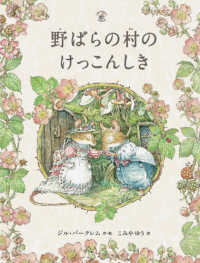- ホーム
- > 洋書
- > ドイツ書
- > Humanities, Arts & Music
- > Linguistics
- > english linguistics
Description
(Text)
Stories about talking animals enjoy an exceptional popularity in English literature and in children's fiction in particular. Animal stories of the final years of the twentieth and the first years of the twenty-first century often fuse motifs of nature with motifs of religion, and in doing so harness religious discourse to an environmental agenda. Examining a corpus of more than two dozen late twentieth century and early twenty-first century talking-animal stories, Anja Höing traces the manifold connections between nature and religion in talking-animal stories. These connections range from descriptions of natural spaces as mystical or spiritual to depictions of animate nature as a genuine deity, and they often include re-conceptualisations of religious motifs in environmental dimensions. Exploring motifs such as the saviour or the devil, the author argues that talking-animal stories construct 'Nature' as a quasi-religious entity and the animal protagonist as an environmental role model. Establishing links between literary texts and current conceptions of ecosystems as well as socio-cultural debates on the human place in nature, this study proposes that many animal stories simultaneously deconstruct and reinforce a human/nature dualism and in doing so reflect the very ideology they seek to challenge.
(Table of content)
Contents
1. Introduction 1
I. Pre-Texts 20
2. Neo-Pagan Talking-Animal Stories 20
II. Perceptions of Nature and the Animal 37
3. Spiritual and Mystical Dimensions of Inanimate Nature 37
3.1 Preconceptions of Places and the Promised Land 37
3.2 Patterns in Nature Description 42
3.3 Supernatural Elements 50
3.4 Emotional Responses and Belonging 52
3.5 Dimensions of Inanimate Nature 56
4. Animate Nature 59
4.1 Personifications of Nature 59
4.2 Signs from Animate Nature 63
4.3 Animate Nature as Reacting Entity 67
4.4 Intervening Help from Animate Nature 71
4.5 Talking Nature 74
4.6 The Wind 77
4.7 Nature: Animacy, Normativity, and Divinity 86
5. Animal Philosophy of Life 91
5.1 Living for the Moment 91
5.2 Playfulness 98
5.3 Animal Joy 100
5.4 Non-Questioning Attitudes 107
5.5 The United Natural World 110
5.6 Implications of the Animal Philosophy of Life 113
III. Animal Religion 118
6. Nature Religion 118
6.1 Spiritualized Natural Forces 118
6.2 Spiritualized Habitats 127
6.3 Universal Energy 130
6.4 The Experience of Pantheism in Death 134
6.5 The Shifting Dimensions of Nature Religion 136
7. Animal Gods 139
7.1 Attributes of Animal Gods 139
7.2 Connection of Animal Gods to Natural Forces 155
8. Devil Figures 162
8.1 Devils as "the Unnatural" 163
8.2 Devils as Necessary Evil in a Balanced System 168
8.3 Depictions of Hell 177
8.4 The Function of Devil Figures in Talking-Animal Stories 179
9. Saviours and Religious Heroes 181
9.1 The Christian Saviour 182
9.2 The Animal Saviour Battling Intrinsic Contradictoriness 184
9.3 The Trickster as Saviour 191
9.4 Animal Saviours 198
10. Religious Mythology 200
10.1 Imagining Origins 201
10.2 Imagining Afterlife 218
10.3 The Functions of Religious Mythology 225
IV. At the Interface between Animal and Human 230
11. Aberrant Animal Societies and the Influence of Humans 230
11.1 Aberrant Animal Societies 230
11.2 A Return to Animal Religion 244
11.3 Humans and Nature 251
Conclusion: Beyond the Animal Worlds 259
Works Cited 267








